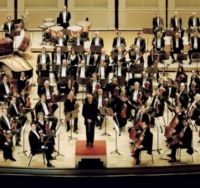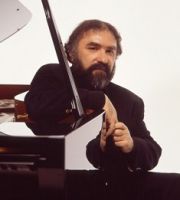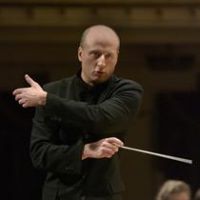Meaty, Engaging Program Set for Carnegie Hall by Järvi and the CSO
Mary Ellyn Hutton
Posted: Feb 13, 2010 - 6:25:41 AM in
reviews_2010

Cincinnati Symphony Orchestra, Paavo Järvi music director
|
Paavo Järvi and the Cincinnati Symphony Orchestra are taking a meaty musical offering to Carnegie Hall on Monday (Feb. 15).
Their program, previewed Friday night (Feb. 12) at Music Hall, comprises all 20th-century music, from Ravel to Bach -- Bach, that is, orchestrated by Anton Webern (Fuga Ricercare in C Minor from "The Musical Offering").

Radu Lupu
|
Guest artist in Bartok's Piano Concerto No. 3 was pianist Radu Lupu, who also will perform with Järvi and the CSO in New York. Framing the concert were Five Nursery Songs from "Mother Goose" by Ravel and Polish composer Witold Lutoslawski's Concerto for Orchestra.
It was a beautifully organized program, with the more "lyrical" music on the first half and the more "intellectual" and rigorous on the second.
Each work seemed like a preparation for the one that followed it. Ravel's Suite, originally a four-hand piano duet for children, seemed to flow naturally into Bartok's Third Piano Concerto, a gentler, less virtuosic work than his two earlier piano concertos. Written literally on his deathbed in 1945, it was intended for his wife Ditta to perform after his death.
Webern's orchestration, a vibrant, pointillistic treatment of Bach's six-voice fugue (Ricercare) was a fitting introduction to Lutoslawski's Concerto, which is suffused with color and invention.
Romanian guru Lupu made an extraordinary impression in Bartok's valedictory concerto. Eschewing a piano bench for a chair, he addressed the keys with total authority, making a point of watching Järvi and the CSO players to help achieve a close collaboration. The mild-mannered Allegretto sparkled, its folk-like melody rendered largely in octaves on the piano. The Adagio religioso (a rare title for Bartok) takes its inspiration from the slow movement of Beethoven's String Quartet Op. 132, written after the composer's recovery from a near-fatal illness and inscribed "A convalescent's holy song of Thanksgiving to the Divinity."
Though Bartok really was fatally ill when he wrote his Third Piano Concerto, it breathes a spirit of hope, a spirit that came through in the otherworldly performance by Lupu and the CSO. Järvi has an uncanny ability to make the CSO speak softly while retaining the utmost clarity and projection, as he did in the lengthy introduction which set the tone for Lupu's eloquent, soulful playing. The CSO evoked bird calls in the contrasting mid-section in Bartok's characteristic "night music" style.
The finale, hardly the reflection of a dying man, was folkish, energetic and just plain fun, sparking a warm ovation from the audience and handshakes and hugs by Lupu, Järvi and members of the CSO.

Paavo Järvi (photo by Mark Lyons)
|
Ravel's Five Nursery Songs -- only two actually stem from Perrault's "Tales of Mother Goose" (Sleeping Beauty and Tom Thumb) -- can be overdone and Järvi was careful not to do so. Each movement was full of childlike innocence, even the concluding "Enchanted Garden" which instead of a grandiloquent crescendo, unfolded like a blossom in the sunlight.
There were many beautiful moments -- the silken texture of "Sleeping Beauty's Pavane," the chirping of the "birds" as they pick up the breadcrumbs dropped by Tom Thumb in the forest (associate concertmaster Rebecca Culnan, a standout all evening, and principal flutist Randolph Bowman) and principal clarinetist Richard Hawley's charming duet with contra-bassoonist Jennifer Monroe as "beauty" and the "beast" in "Conversations of Beauty and the Beast." There were startling moments, too, my favorite, perhaps, being the indescribable mix of color (iridescence?) at the end of "Beauty and the Beast."
Bach's Ricercare got loving treatment from Webern, who filled in Bach's score (no particular instrumentation was specified by Bach) in contemporary painterly fashion. Themes and motives were handed off among the instruments, and the shape and flow of the work took on a distinctive flavor. The CSO principal winds and brasses, plus timpani, harp and strings made it congenial and engaging, like an old friend one has not seen for a long time.
Lutoslawski's 1954 Concerto for Orchestra is something of a companion piece to its famous predecessor by Bartok (and unjustly overlooked by comparison). Scored for huge orchestra, including triple winds, quadruple brasses, a raft of percussion, two harps, piano and celeste, it is a paintbox of color. It is also more of a mid-century piece than Bartok's relatively conservative work. (Järvi and the CSO have paired them on a fine recording for Telarc.)
Lutoslawski loses no time in seizing the listener. The first movement (Intrada) opens with 30-some bars of sharp timpani strokes, delivered handily by CSO timpanist Patrick Schleker. Everyone gets into the act in this brilliant, half-hour concerto, from the double basses to the celeste (which repeats the timpani strokes four octaves higher near the end of the Intrada).
The strings danced nimbly in the second movement (Capriccio) and there was a gorgeous moment in the contrasting Arioso section when Bowman's distinctively sweet flute was heard emerging from the texture following a big cymbal crash. The movement concluded with deep, fantastic rumblings in the basses and drums.
The finale, a Passacaglia with 17 variations, followed by a Toccata and a Corale, opened with a soft, spooky announcement of the passacaglia theme by the basses, piano and harp. There was a lovely solo by Christopher Philpotts on English horn and there were some brass "raspberries" (rapid staccato effects) momentarily reminiscent of Bartok.
The Toccata portion of the finale featured virtuosic playing by the orchestra and the Corale was a burnished beauty. The Presto ending was electric, with the CSO forces joined, piccolos flickering on top, all fueled with crouching intensity and slashing motions of the baton by Järvi.
Prediction: New York will love it. If you can be there, the concert is 8 p.m. Monday (Feb. 15) at Carnegie Hall. For information, call (212) 247-7800, or visit http://www.carnegiehall.org/article/box_office/ovr_box_office.html
Repeat in Cincinnati is 8 p.m. tonight (Feb. 13) at Music Hall. Tickets, beginning at $10, are available at (513) 381-3300, the Music Hall box office from 10 a.m. to 2 p.m. and one hour before the performance, or visit www.cincinnatisymphony.org



